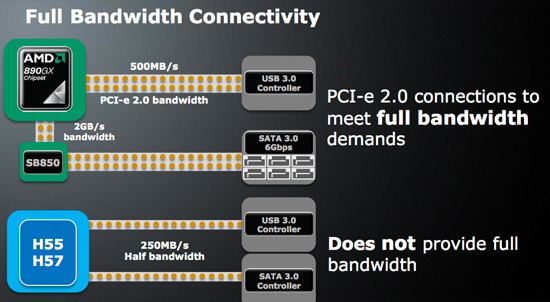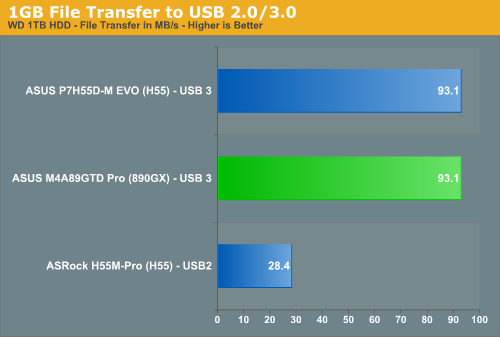AMD's 890GX Chipset - Same Graphics, Better South Bridge
by Anand Lal Shimpi on March 2, 2010 4:36 AM EST- Posted in
- CPUs
Better Suited for USB 3.0?
A little known fact is that Intel’s P55/H55/H57 chipsets run their PCIe lanes at 2.5GT/s. Meaning that a PCIe x1 lane off the chipset only offers 250MB/s in each direction. Aggregate bandwidth is 500MB/s, but that’s only attained if you’re reading at 250MB/s and writing at 250MB/s.

AMD runs all of its PCIe lanes at 5.0GT/s, so a single PCIe x1 slot offers 500MB/s up and 500MB/s down.
Neither AMD nor Intel have integrated USB 3.0 controllers, so they must rely on NEC’s PCIe-to-USB3 controller. AMD’s 890GX chipset offers roughly twice the bandwidth between the chipset and the USB 3 controller.
Today that doesn’t amount to anything. No currently available USB 3.0 peripheral can saturate PCIe 1.0 speeds, but down the road AMD’s approach will avoid any bottlenecks. I’d expect this to start being a problem towards the end of 2010 and into 2011 as we start getting more ONFI 2.0 NAND equipped SSDs that can boast 300MB/s+ read speeds.
USB Performance
No chipset launch article is complete without a never-before-seen problem and we think we hit our quota. We stumbled across an issue using Sharkoon’s USB QuickPort and our ASUS M4A89GTD Pro motherboard; hot-plugging the device into a USB 2.0 port results in a system crash whether you’re in the OS, during POST or within BIOS. The USB 3.0 ports will occasionally work with the drive and we did manage to scramble a quick test (see the graph at the bottom of the page), although the symptoms are largely the same (system hangs, loss of display).
Now, the Sharkoon QuickPort comes with its own power adapter (which it needs to work) and is fully USB 2.0/3.0 compatible, so it should not draw excessive current from the USB ports. There’s always the chance that we’ve got a faulty unit, but bear in mind that it works perfectly with nine motherboards featuring various chipsets.
One thing we noticed is that the M4A89GTD Pro seems to cut power to other USB devices briefly when plug we plug the QuickPort cable into a socket. We tried plugging the drive in while the motherboard is powered down, doing so does allow it to post and enter the OS. After that, Windows finds our USB hard drive and proceeds to load drivers. Trouble is that the drive is not displayed in the ‘My Computer’ menu, and trying to access the drive via the Disk Management snap-in does not work either; we’re continually greeted with a refresh error.
We’re leaning towards the notion of a faulty motherboard at present. ASUS have been notified and have dispatched a new board which should arrive with us shortly. In the meantime, all we’ve got to show for our efforts is 1GB file transfer time over the AMD SB850 vs. Intel’s H55/H57 to the NEC D720200F1 USB 3.0 port using a couple of 1TB Western Digital Caviar hard drives. We know it’s far from an ideal test but will have to suffice for today - sorry folks!

There’s little to divide the boards in a one 1GB file transfer using the SATA HDD’s, it’s obvious that the drives are a bottleneck. We’re aiming to put a couple of 6G SATA drives through their paces on these boards in the near future so we get a better idea of what USB 3 technology can do.










65 Comments
View All Comments
Taft12 - Tuesday, March 2, 2010 - link
Fully agreed here, the lack of chipset competition has led to stagnation on both the AMD and Intel sides of the fence.Especially Intel, Anand admitted in the H55 coverage that Intel did not reduce chipset pricing even though removal of the IGP reduced their costs significantly. This horseshit would not occur if Nvidia and others weren't being blocked from creating their own offerings.
Penti - Tuesday, March 2, 2010 - link
They don't have licenses to produce chipsets any more. I fully disagree that it has led to stagnation though. Removing the memory controller on AMDs didn't lower the cost either. Both AMD and Intel finally has some enterprise (business) features such DASH and vpro too. Others simply couldn't keep up, nVidia killed ULI when they bought them, SiS and VIA has dropped out since a long time ago. Gaming components like nVidia 980a won't do a dent regardless of price.MadMan007 - Tuesday, March 2, 2010 - link
Hey Anand, thanks for including a modern low-end card for reference. I do have a request for what might be a useful article wrt IGPs for you. I'd like to know not how poor IGPs are compared to modern cards but rather to which *older* graphics card they are equivalent. Personally I haven't gotten many new games in a while and with Steam sales have been picking up some older ones too, there may be others in the same boat. Now when a game says it requires a much older card like a GF3 or Radeon 9000 or what have you I am pretty sure a modern IGP is better but once things start getting in to DX9 cards I'm not so sure. Would an IGP be equivalent to a 6600GT, or a Radeon 850?If you were to have someone do an article looking at this with older games that would be awesome and a great service to those who just play older games at this point. Finding IGP performance on older games is not easy.
nice123 - Tuesday, March 2, 2010 - link
Remember, GlobalFoundries is new. AMD are still using TSMC's 55nm process for this chipset. This is most probably because their 40nm process is absolutely crap. (as seen with the Radeon 5xxx yields and lack of Fermi)When AMD move to GlobalFoundries I think their hardware will pick up more, we won't have TSMC screwing up every single process they do.
Penti - Tuesday, March 2, 2010 - link
Still? What are you talking about, practically nobody uses the latest node for chipsets and many other none bleeding edge speed ASICs. At least they moved from 65nm. Intel chipsets are manufactured at 65nm.They won't move to GlobalFoundries for fabbing chipset/GPU logic till Liano APUs I guess they will design chipsets for GF then too.
Foxi - Tuesday, March 2, 2010 - link
AMD should ban Anand from testing theirs stuffs. It's a shame and pathetic as well. :sstrikeback03 - Tuesday, March 2, 2010 - link
lol, which part of this article offended you, fanboi?Penti - Tuesday, March 2, 2010 - link
How about the IOMMU (AMD-Vi) support in the SB850 chipset? It's supported right? I want to know if the chipset and bios combo has it working.semo - Tuesday, March 2, 2010 - link
Wondering about that too. I've seen articles here test for virtualization performance but only in the server space. Would be good to see more info about these sort of things around herePenti - Tuesday, March 2, 2010 - link
Yeah it works for SR5650-70-90/SP5100 server chipset, but it's not identical even if it's the chip it's based of. So I was wondering if there's really support in the silicon and perhaps more important if it's supported in the BIOS. Otherwise it's not really interesting for me. I will still only consider the Opteron platform for an AMD machine then and it makes choosing a Intel machine so much easier. But I guess not since AMD don't mention it. Might not matter for desktops, but it do for workstations and Intel desktops supports it (IOMMU). AMD-V is of course there but that's a whole other matter.